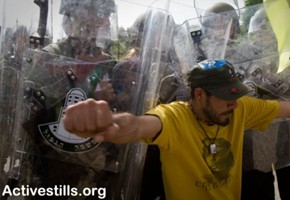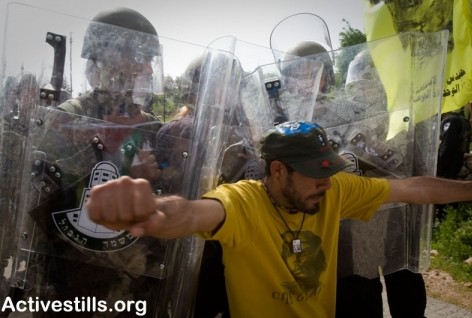
Activists against the occupation barrier in the area of the West Bank Palestinian village of Bil’in vowed this week to continue their struggle, even though the IDF (Tzahal) began relocating the fence earlier this week.
Today, on Friday, protesters will hold their weekly rally against the barrier along the regular route to the old location of the fence. In the future they will protest against the barrier at its new location.

A demonstration in Bil’in (Photo: Activestills)
Israeli troops on Wednesday began taking down barbed wire around the Palestinian village of Bil’in, focus of years of protests against Israel’s controversial separation barrier.
Army bulldozers were seen razing a watchtower on a hill overlooking the village but the military declined to comment on the significance of the operation.
In 2010, the country’s defense ministry announced that it would begin altering the course of the barrier around Bil’in in conformity with a 2007 Supreme Court ruling that it significantly impinged on the property rights of Palestinian landowners.
Israel says the wall is designed to prevent attacks but it is widely viewed as a land grab, isolating villagers from fertile farmland, towns from water sources, and communities from relatives, in parts of the West Bank illegally annexed to Israel.
The total separation it ensures between the Palestinian population in the West Bank and Israelis without personal connections in the area, have resulted in the popular term for the network of concrete walls, fence, ditches and watchtowers as the apartheid wall.
When the 709-kilometer barrier is complete, 85 percent of it will have been built inside the occupied West Bank, cutting at times as many as 22 kilometers into the occupied land.
“The Israeli army began removing the barbed wire around the village today, four years after the ruling of the Israeli court,” said Rateb Abu Rahmah, one of the organizers of the weekly protests in the village.
“The dismantlement of the wall is the fruit of the struggle by the people of the village,” he added.
The Palestinians’ protests, with the participation of Israeli peace activists and international solidarity militants, against the barrier in Bil’in have met with a sometimes deadly response from the Israeli occupation forces.
In January, a woman protester, Jawaher Abu Rahmah, died after inhaling tear gas. Her brother Bassem Abu Rahmah died in April 2009 after being struck on the head by a tear-gas canister.
In a non-binding 2004 judgment, the International Court of Justice called for the dismantling of all parts of the separation barrier built on occupied territory.
After a visit to Israel and the Palestinian territories last month, UN Under Secretary General for Humanitarian Affairs Valerie Amos described the barrier’s impact on the lives of ordinary Palestinians as “devastating.” “I witnessed first hand the impact of the barrier on Palestinian communities. I was deeply disturbed by what I saw,” she said.
In a statement sent out Thursday morning, the village’s Popular Committee declared the following day, when dozens are expected to come out for the weekly Friday protest, to be the “last day of the old path of the Barrier on village’s lands, and the beginning of the struggle against the new path.” The statement said the protesters planned to take down the wall and regain access to their lands on the far side.


